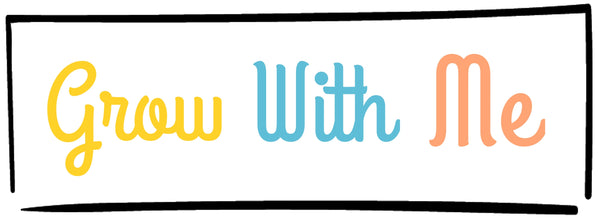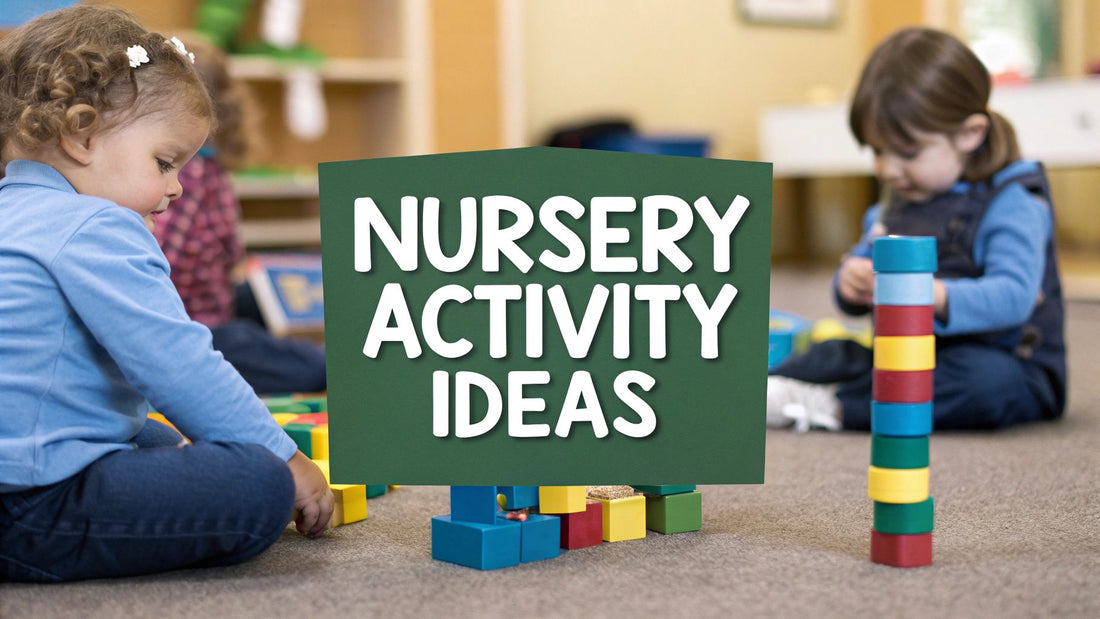
10 Engaging Nursery Activity Ideas for 2025
Share
Welcome to the vibrant world of nursery-aged children, where every moment is a chance for discovery and growth. As parents, grandparents, and carers, we are constantly searching for fresh, engaging nursery activity ideas that not only entertain but also nurture crucial developmental milestones. This guide moves beyond the obvious, offering ten thoughtfully curated activities designed to spark curiosity, build skills, and create joyful memories.
This listicle is your practical resource for purposeful play. We will explore everything from the tactile wonders of sensory bins to the imaginative realms of a dramatic play centre. Each idea is presented with clear, actionable steps, a list of simple materials, and an explanation of the key developmental benefits.
You will find specific examples and implementation details to help you set up these experiences quickly and effectively. Our goal is to provide a comprehensive yet easy-to-digest collection of activities that lay a strong foundation for a lifetime of learning. We've organised everything to help you transform everyday moments into extraordinary adventures in development. Let’s dive into a world of creativity and exploration.
1. Sensory Play Bins: A World of Tactile Discovery
Imagine a contained world where your child can safely explore different textures, practise pouring, and let their imagination run wild. That's the magic of a sensory bin. These simple containers, filled with materials like coloured rice, water beads, or even natural items like leaves and acorns, offer a rich, multi-sensory experience that is a cornerstone of early years education.
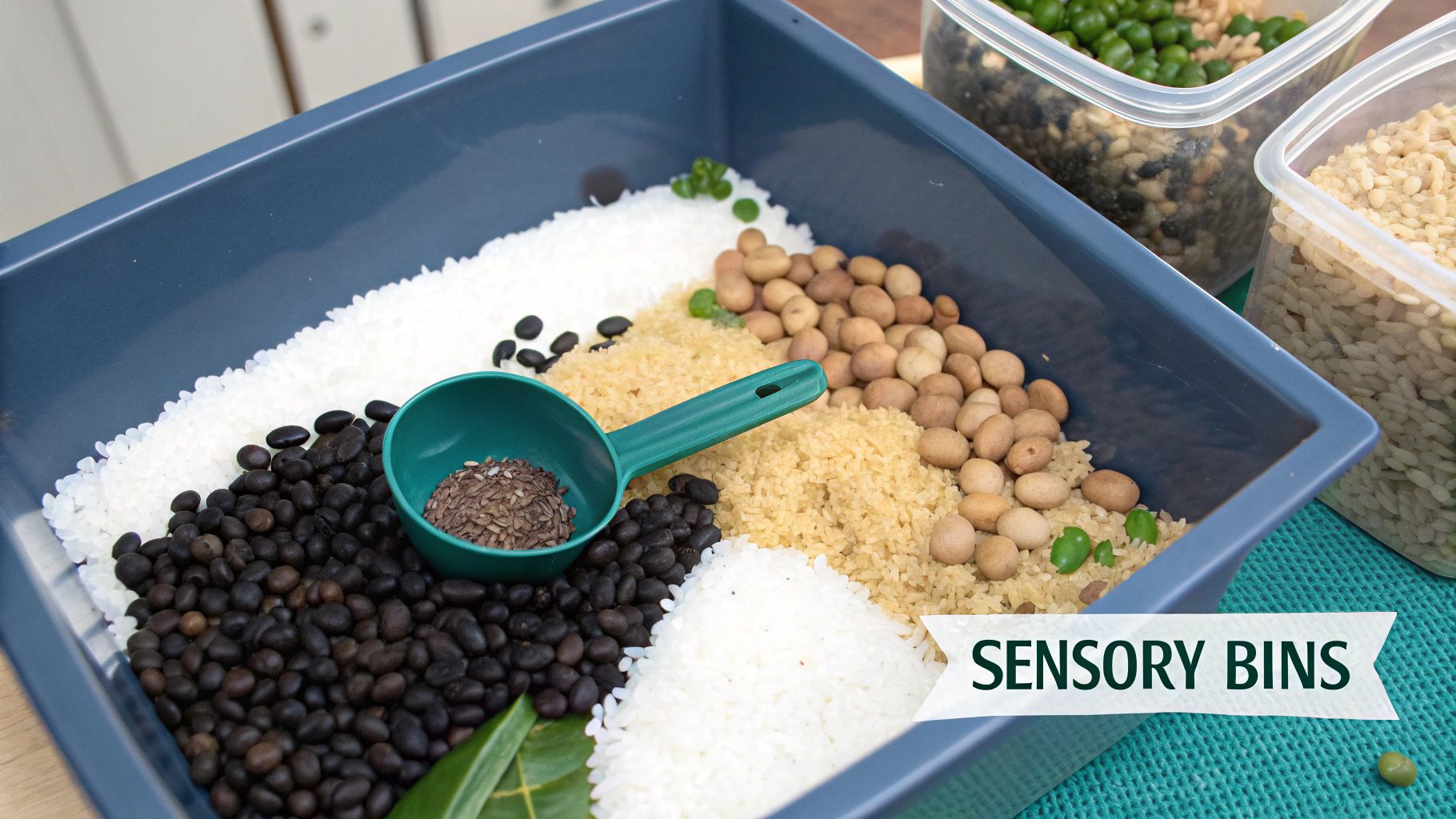
This focused space for self-directed play is one of the most versatile nursery activity ideas you can implement. Children can develop crucial fine motor skills, experiment with cause and effect, and learn concepts like colour sorting, counting, and measurement in a hands-on, intuitive way.
How to Get Started
Setting up a sensory bin is simple. You only need a shallow container, a sensory base (like uncooked pasta or oats), and some tools for exploration.
- Ocean Theme: Use blue-dyed rice or water beads as the base, adding plastic sea creatures, shells, and small cups for scooping "water."
- Construction Zone: Fill the bin with lentils or split peas to mimic gravel, and add small toy diggers, lorries, and blocks.
- Autumn Harvest: Combine dried corn kernels, acorns, conkers, and mini pumpkins with scoops and small pots.
Pro Tip: For an easy clean-up solution, place the sensory bin on a large play mat or an old shower curtain. This contains any spills and makes tidying up much quicker.
Sensory bins are not just fun; they are powerful developmental tools. They encourage problem-solving and can have a calming, therapeutic effect on young children. To discover more fantastic sensory bin setups, you can explore further sensory play ideas for toddlers.
2. Nature Scavenger Hunts: Exploring the Great Outdoors
Turn any walk in the park or garden exploration into a thrilling adventure with a nature scavenger hunt. This activity encourages children to become little detectives, using simple picture lists or prompts to find specific natural treasures. It’s an engaging way to combine physical exercise, sensory exploration, and early scientific observation in the fresh air.
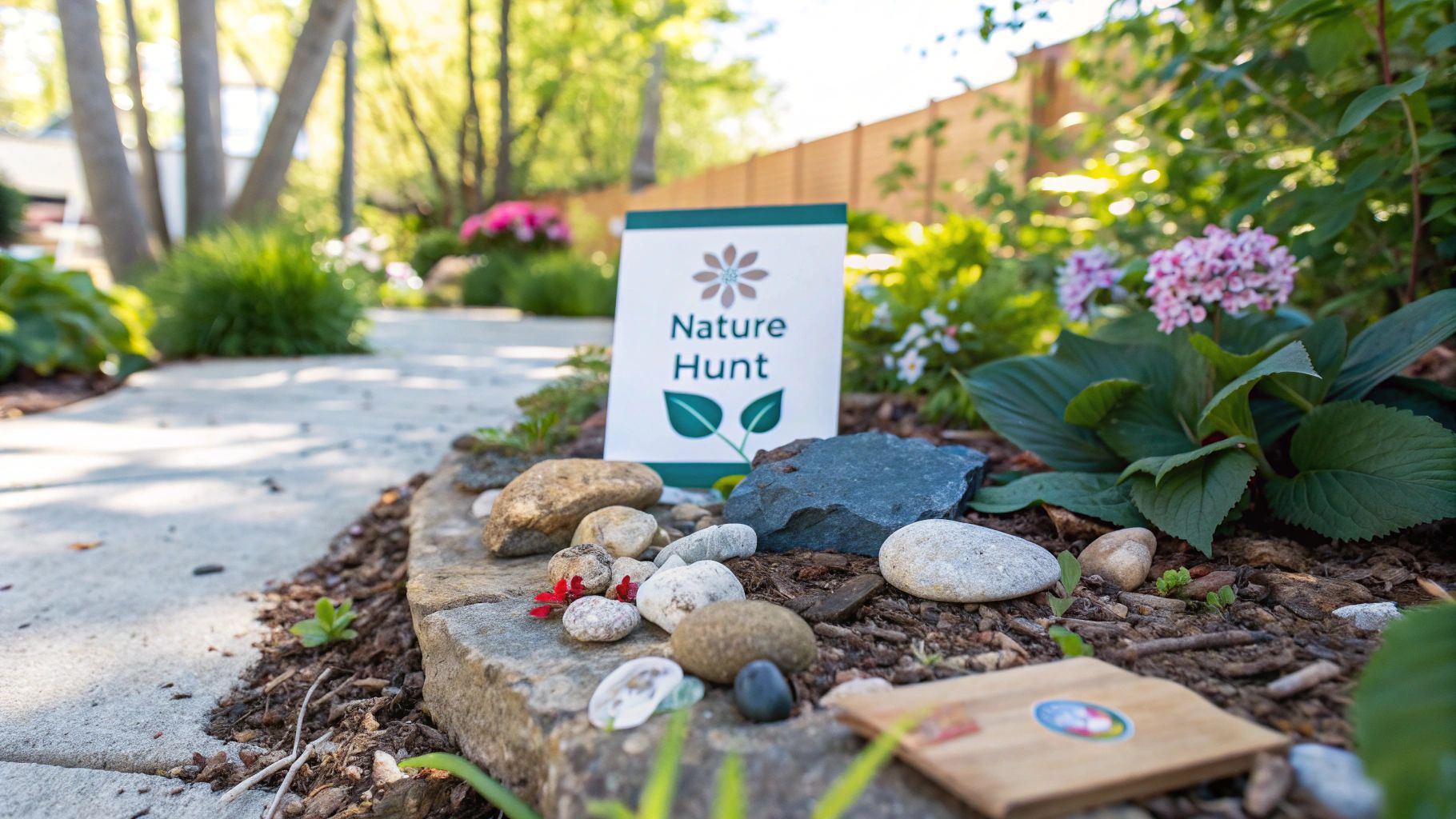
As one of the most adaptable nursery activity ideas, a scavenger hunt can be tailored to any season or environment. Children develop their observation skills, learn new vocabulary to describe what they see and feel, and gain a greater appreciation for the natural world around them. It’s a wonderful opportunity for guided learning and discovery.
How to Get Started
Organising a nature hunt is wonderfully simple and requires minimal preparation. All you need is a safe outdoor space and a list of items for the children to find.
- Texture Hunt: Create a list with items like "something smooth" (a pebble), "something rough" (bark), and "something soft" (a feather or moss).
- Colour Quest: Challenge children to find natural objects that match different colours, such as a green leaf, a brown twig, and a yellow dandelion.
- Shape Search: Look for natural items that resemble basic shapes, like a round stone or a straight stick.
Pro Tip: Use picture cards instead of a written list for pre-readers. This empowers them to complete the hunt independently and builds their confidence.
Nature scavenger hunts are more than just a game; they foster curiosity, physical activity, and a connection to the environment. Following up with a craft activity using the collected items can extend the learning and creativity even further.
3. Simple Science Experiments: Sparking Early Curiosity
Transform your nursery into a mini-laboratory where children can ask questions, make predictions, and discover the wonders of the world around them. Simple science experiments are fantastic for introducing foundational concepts in a playful, hands-on way. Watching a "volcano" fizz or seeing colours mix for the first time creates unforgettable moments of awe and understanding.
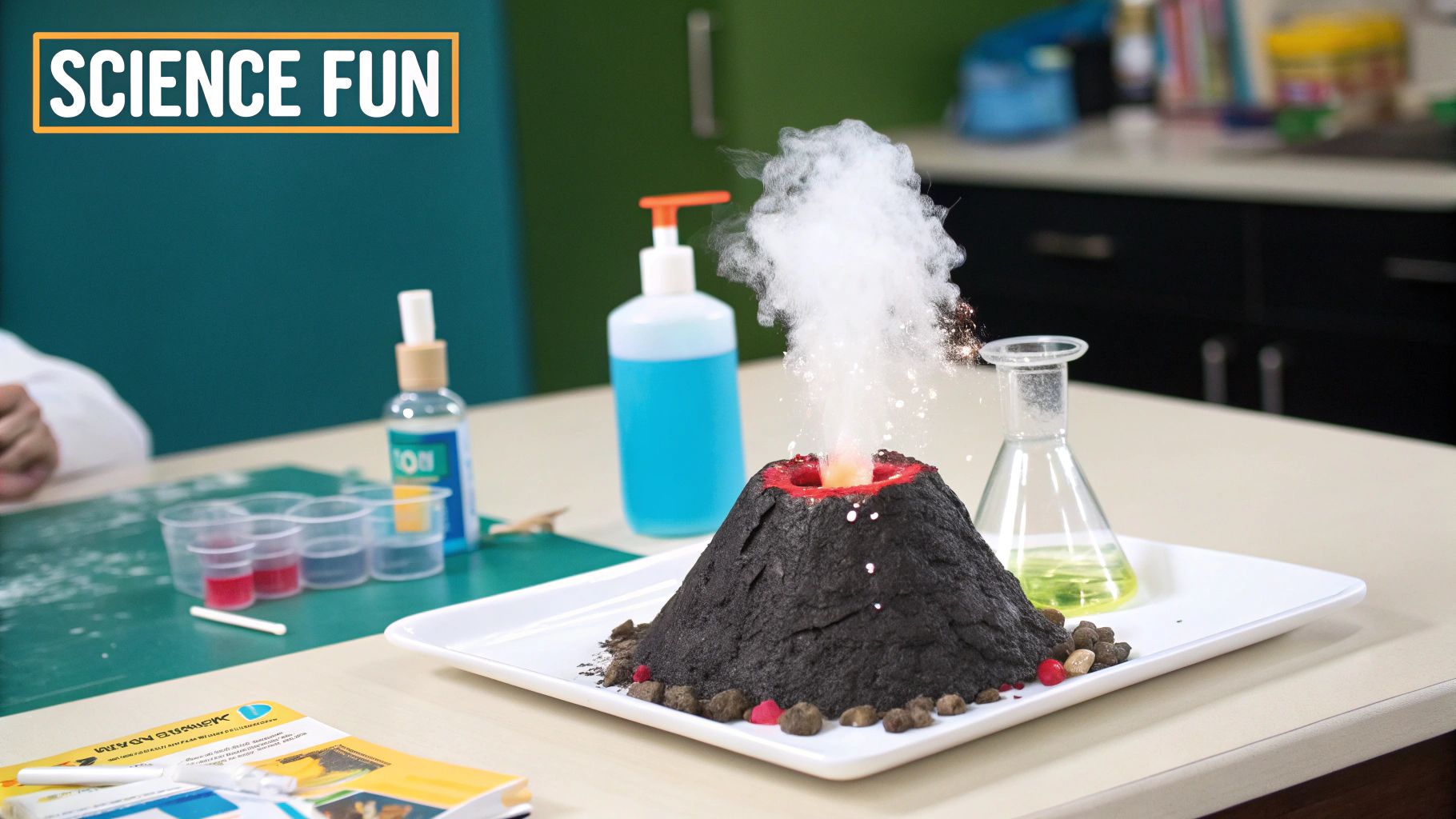
These activities are some of the most engaging nursery activity ideas for fostering critical thinking. They encourage children to observe, predict what might happen, and then reflect on the results. This simple process builds a strong foundation for scientific thinking, problem-solving, and a lifelong love of learning.
How to Get Started
You don’t need a lab coat to get started, just a few common household items and a sense of adventure. Focus on simple, visual reactions that are safe and easy for little hands to participate in.
- Classic Volcano: Combine baking soda in a small bottle and add vinegar mixed with red food colouring for a dramatic, fizzy eruption.
- Floating & Sinking: Fill a basin with water and provide various objects (a leaf, a toy car, a crayon, a cork) for children to test and sort.
- Magic Milk: Add drops of food colouring to a shallow dish of milk. Touch a cotton bud dipped in washing-up liquid to the colours to watch them swirl away.
Pro Tip: Before starting, always ask, "What do you think will happen?" This encourages children to form their own hypotheses and makes the final reveal even more exciting.
Science experiments are not just about the outcome; they are about the process of discovery. They nurture a child's natural curiosity and empower them to explore how things work. To find more inspiration for your budding scientist, you can explore further ideas for simple science experiments.
4. Art and Craft Projects: Unleashing Young Imaginations
Providing children with a blank canvas and a variety of materials is a fantastic way to unlock their creative potential. Art and craft projects, from simple finger painting to sculpting with playdough, offer a powerful medium for self-expression, allowing children to communicate ideas and emotions long before they have the words to do so.
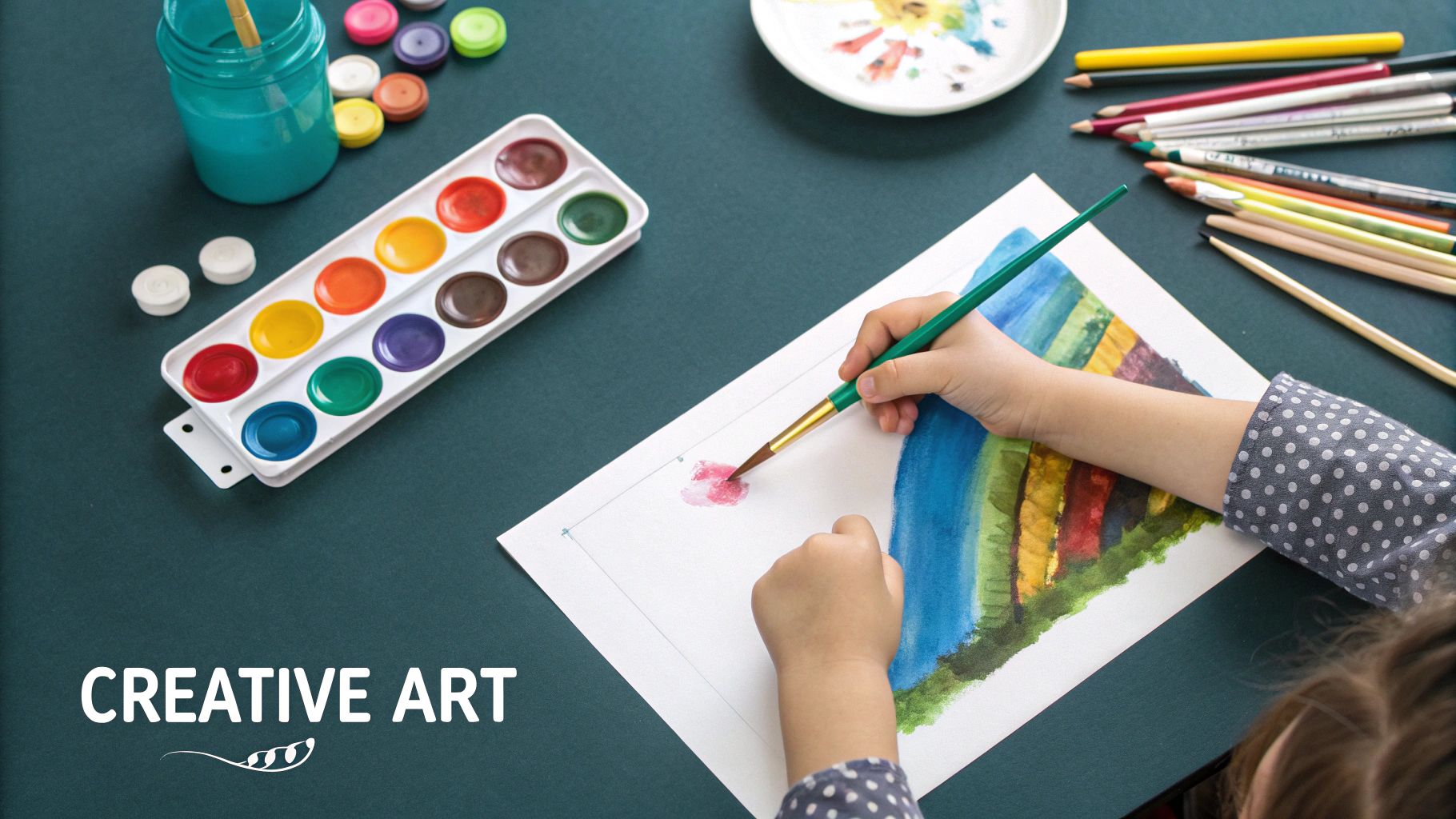
These hands-on sessions are fundamental nursery activity ideas that foster fine motor skills, colour recognition, and an understanding of cause and effect. Holding a paintbrush, squeezing a glue bottle, or rolling out playdough all contribute to building the dexterity and hand-eye coordination necessary for future writing skills.
How to Get Started
The key to successful art activities is to focus on the process, not the final product. Allow children the freedom to explore materials without pressure.
- Seasonal Handprints: Use child-safe paint to turn handprints into seasonal characters like reindeer at Christmas or spooky spiders for Halloween.
- Nature Collage: Go on a nature walk to collect leaves, twigs, and flower petals, then use glue to arrange them on a piece of card.
- Playdough Sculptures: Provide playdough in various colours along with child-safe tools like rolling pins and cookie cutters to create imaginative figures.
Pro Tip: Keep a "creation station" with accessible, age-appropriate supplies like chunky crayons, scrap paper, and stickers. This encourages spontaneous creativity and gives children ownership over their artistic exploration.
Art and craft projects build confidence as children see their ideas take physical form. Displaying their finished work prominently shows them that their efforts are valued, reinforcing a positive sense of self-esteem and pride in their accomplishments.
5. Music and Movement Activities: A Symphony of Growth
From the simplest clap to a joyful wiggle, music and movement are fundamental forms of expression for young children. These activities combine songs, dance, and simple instruments to create a lively environment where children can build confidence, develop coordination, and enhance their communication skills. It’s about more than just making noise; it’s about learning rhythm, listening, and working together.
This dynamic category of nursery activity ideas taps into a child’s natural inclination to move. Through music, children can improve gross motor skills, practise following directions, and expand their vocabulary in a fun, pressure-free setting. It’s a powerful tool for both physical and cognitive development.
How to Get Started
You don’t need to be a musician to lead these activities. Simple, repetitive songs and a willingness to be silly are all that’s required to bring the joy of music to your nursery.
- Action Songs: Classic rhymes like 'Head, Shoulders, Knees and Toes' or 'The Wheels on the Bus' are perfect for linking words with physical actions.
- Freeze Dance: Play different styles of music and encourage children to dance freely, freezing in their poses when the music stops. This is great for developing self-regulation.
- Simple Instrument Band: Provide homemade shakers (rice in a bottle), rhythm sticks, or toy drums and let children explore different sounds and beats as you sing together.
Pro Tip: Use props like colourful scarves, ribbons, or even bubbles to encourage different types of movement. Flowing scarves can inspire graceful dancing, while bubbles can prompt jumping and reaching.
Music and movement are essential for holistic development, supporting everything from emotional expression to early literacy. By incorporating these activities, you provide a vibrant outlet for energy and a joyful foundation for a lifelong appreciation of music.
6. Dramatic Play Centres: Where Imagination Takes the Lead
Imagine a corner of the nursery transformed into a bustling café, a busy doctor's surgery, or a well-stocked grocery shop. This is the power of a dramatic play centre, a designated space equipped with props and costumes that invites children to step into new roles and act out real-life scenarios. This type of immersive play is fundamental for social and emotional development.
Dramatic play is one of the most effective nursery activity ideas for developing language, empathy, and problem-solving skills. By taking on different roles, children learn to negotiate with peers, understand different perspectives, and make sense of the world around them in a safe and creative environment.
How to Get Started
Creating an engaging dramatic play centre is all about the details. Start with a theme and gather props that bring the scenario to life.
- Restaurant/Café: Set up a small table with menus, notepads, aprons, and a collection of play food. A toy till can add an extra layer of authenticity.
- Veterinarian Office: Fill the area with soft toy animals, toy medical kits, bandages, and clipboards for taking "notes."
- Grocery Shop: Use empty food containers, a small shopping trolley or basket, play money, and a cash register to create a realistic shopping experience.
Pro Tip: Rotate the theme of your dramatic play centre every few weeks to keep children engaged and introduce them to new vocabulary and social situations. Connecting the theme to a recent story or a community outing can make the experience even more meaningful.
These imaginative spaces are more than just games; they are practice grounds for life. They help children build confidence, practise cooperation, and express their understanding of complex social roles and interactions.
7. Building and Construction Play: Engineering Young Minds
From the satisfying click of magnetic tiles to the careful balancing of wooden blocks, construction play is a fundamental part of early childhood development. It's an open-ended activity where children become architects, engineers, and city planners, transforming simple materials into towering structures, sprawling cities, or imaginative creations.
This hands-on exploration is one of the most powerful nursery activity ideas for developing spatial reasoning, problem-solving skills, and resilience. As children figure out how to make their tower taller or their bridge stronger, they are engaging with core principles of physics and engineering, all while enhancing their fine motor control and hand-eye coordination.
How to Get Started
Creating an inviting construction area is all about providing a variety of materials and the space to use them.
- Classic Block City: Use a set of wooden unit blocks of various shapes and sizes. Encourage children to build roads, houses, and towers on a large play mat.
- Magnetic Marvels: Provide magnetic tiles on a flat surface or even a magnetic board. Children can explore 2D shapes and how they combine to create 3D structures.
- DUPLO World-Building: Offer DUPLO bricks with a theme, such as a farm or a community, and add corresponding small figures or vehicles to inspire narrative play.
Pro Tip: Before tidy-up time, take photographs of your child's creations. This validates their effort, creates a record of their progress, and makes the process of dismantling their hard work a little easier.
Building and construction play is more than just stacking blocks; it’s about testing hypotheses, collaborating with others, and bringing imagination to life. It fosters creativity and critical thinking, laying the foundation for future learning in science, maths, and the arts.
8. Water Play Activities: Splashing into Science and Fun
Few things capture a young child's attention quite like water. Water play offers a delightful sensory experience, allowing children to explore scientific concepts like volume, flow, and buoyancy in a completely natural and engaging way. Whether it’s in a designated water table or a simple basin in the garden, these activities are both calming and stimulating.
This hands-on exploration is one of the most classic nursery activity ideas for good reason. It supports the development of fine and gross motor skills as children pour, splash, and lift. It also encourages concentration, problem-solving, and cooperative play as they share tools and discover how water moves and behaves.
How to Get Started
Setting up for water play is wonderfully simple and can be adapted for indoor or outdoor settings. All you need is a water-tight container and a few engaging tools.
- Floating & Sinking: Provide a basin of water with various objects like sponges, plastic toys, leaves, and small stones to see which ones float and which sink.
- Bubble Factory: Add a few drops of child-safe soap to the water and give children whisks, straws, or bubble wands to create mountains of bubbles.
- Potion Making: Offer various containers, funnels, jugs, and maybe a touch of food colouring, allowing children to mix, measure, and pour their magical "potions."
Pro Tip: Always ensure constant supervision during any water-based activity, no matter how shallow the water is. Have towels and a change of clothes ready to make the transition afterwards smooth and comfortable.
Water play is a foundational activity that teaches complex ideas through simple, joyful interaction. It’s a therapeutic and educational experience that taps into a child’s innate curiosity about the world around them.
9. Story Time and Book Activities
Imagine a simple story transforming into a grand adventure, where children don't just listen but become part of the narrative. That's the power of interactive story time. This activity moves beyond simply reading words on a page to creating an immersive experience that ignites a lifelong love for books and builds foundational literacy skills.
This approach is one of the most powerful nursery activity ideas for developing language, comprehension, and imagination. By using props, different voices, and follow-up crafts, you help children connect with characters and plots on a deeper level, making reading an active and exciting event rather than a passive one.
How to Get Started
Bringing stories to life is simple and requires little more than a good book and some enthusiasm.
- Interactive Storytelling: Use puppets or props that match the story. For a book about a bear, bring a teddy bear. Use sound effects for animals or weather.
- Dramatic Play: After reading a favourite story, encourage the children to act it out. Lay out simple costumes or props and let them become the characters.
- Book-Related Crafts: Extend the story through art. If you read "The Very Hungry Caterpillar," create caterpillars using egg cartons and paint.
Pro Tip: Create a dedicated cosy reading corner with soft cushions, good lighting, and a basket of accessible books. This makes story time a special, anticipated part of the day.
Interactive reading nurtures empathy, improves concentration, and builds vocabulary. For younger children, choosing the right books is key. You can find inspiration by exploring the best board books for babies.
10. Gardening and Plant Care
Connecting children with nature from a young age fosters a sense of wonder and responsibility. Gardening and plant care activities bring the magic of the natural world into the nursery, allowing little ones to get their hands dirty while learning about life cycles, patience, and where their food comes from. This hands-on experience provides a powerful, living lesson in science.
This is one of the most rewarding nursery activity ideas as it provides tangible results over time. Children learn to nurture and care for something, developing empathy and an understanding of cause and effect. Observing a tiny seed sprout and grow into a plant is an unforgettable experience that introduces basic biology in an engaging, memorable way.
How to Get Started
You don't need a large garden to start; a few pots on a windowsill will do. The key is choosing plants that offer a quick and visible reward for the children's efforts.
- Classroom Herb Garden: Plant fast-growing herbs like mint, basil, or chives. The children can enjoy the sensory experience of smelling and tasting the leaves.
- Bean in a Jar: Grow a bean plant in a clear container or plastic bag against a window. This allows children to see the roots grow downwards and the stem upwards.
- Sunflower Competition: Plant sunflower seeds and create a chart to track their height. This is a brilliant way to introduce measurement and friendly competition.
Pro Tip: Create a simple watering and observation schedule with pictures. This helps children take ownership of the task and builds a consistent routine, teaching them about responsibility and commitment.
Gardening activities are not just about planting; they are about observing, documenting, and understanding the process of growth. This connection to the natural world is a vital part of early childhood development and can inspire a lifelong love of nature.
10 Nursery Activities Comparison Guide
| Activity | Implementation Complexity 🔄 | Resource Requirements ⚡ | Expected Outcomes 📊 | Ideal Use Cases 💡 | Key Advantages ⭐ |
|---|---|---|---|---|---|
| Sensory Play Bins | Moderate | Moderate (variety of materials) | Sensory development, fine motor skills | Indoor contained sensory exploration | Hands-on, customizable, multi-sensory |
| Nature Scavenger Hunts | Low | Low (natural items, cards) | Observation, classification, physical activity | Outdoor, nature-based learning | Promotes outdoor time, environmental awareness |
| Simple Science Experiments | Moderate | Low to moderate (household items) | Critical thinking, scientific curiosity | Hands-on science introduction | Immediate results, fosters inquiry |
| Art and Craft Projects | Moderate | Moderate to high (various supplies) | Creativity, fine motor development | Creative expression, curriculum integration | Enhances creativity, therapeutic benefits |
| Music and Movement Activities | Low to moderate | Low (instruments, space) | Gross motor skills, language, social skills | Group or individual movement | Engaging, multi-domain development |
| Dramatic Play Centers | High | High (props, costumes, space) | Social-emotional skills, language, cooperation | Role-playing, social skill development | Encourages imagination, communication |
| Building and Construction Play | Moderate | Moderate to high (blocks, LEGO) | Spatial reasoning, planning, fine motor skills | STEM and engineering foundations | Develops math and engineering concepts |
| Water Play Activities | Moderate | Moderate (water setup, tools) | Sensory regulation, scientific concepts | Therapeutic sensory play | Calming, teaches measurement and flow |
| Story Time and Book Activities | Low | Low to moderate (books, props) | Literacy, vocabulary, listening skills | Literacy development, storytelling | Builds foundation for reading, language |
| Gardening and Plant Care | Moderate to high | Low to moderate (seeds, soil) | Responsibility, life science knowledge | Long-term nature connection | Teaches nurturing, life cycles |
Bringing Purposeful Play into Your Everyday
As we have explored through this extensive list of nursery activity ideas, the foundation of early childhood development is built not on formal lessons, but on the rich, engaging power of purposeful play. From the tactile exploration of sensory bins and the creative expression found in art projects, to the cognitive challenges of simple science experiments and construction play, each activity offers a unique pathway for growth. These experiences are far more than just ways to pass the time; they are the essential building blocks for your child’s brain.
By intentionally weaving these activities into your daily or weekly rhythm, you are actively nurturing crucial skills. You are helping your little one develop fine and gross motor control, fostering problem-solving abilities, expanding their vocabulary, and encouraging a deep-seated sense of curiosity about the world around them. The beauty of these ideas lies in their simplicity and adaptability, proving that you don’t need expensive toys or elaborate plans to create meaningful learning moments.
Embracing the Journey of Discovery
The most significant takeaway is to embrace the process over the product. A nature scavenger hunt is less about finding every item on a list and more about observing the texture of a leaf or the colour of a flower. A dramatic play session isn’t about a perfect performance; it’s about exploring emotions and social roles.
Remember these key principles as you move forward:
- Follow Your Child's Lead: Pay attention to what sparks their interest. If they are fascinated by pouring water, lean into water play. If they are captivated by stories, expand your story time activities. Their curiosity is your greatest guide.
- Embrace the Mess: Learning is often messy. Whether it’s paint on their hands, soil from the garden, or water splashed on the floor, these messes are signs of a child who is deeply engaged in the act of discovery.
- Stay Present and Engaged: Your participation is the magic ingredient. When you get down on the floor to build a tower, sing along during music time, or ask questions during a science experiment, you are strengthening your bond and validating their efforts.
The true value of these nursery activity ideas is realised when they become a joyful, consistent part of your routine. You are not just teaching your child; you are building a bank of cherished memories, fostering a lifelong love of learning, and providing the secure, stimulating environment they need to thrive. Each small moment of shared play contributes to a much larger picture of a happy, confident, and capable child.
Ready to bring expertly designed, stage-based play into your home without the stress of planning? Discover Grow With Me and receive curated play kits filled with beautiful, sustainable toys and activities that align perfectly with your child's developmental milestones. Explore the Grow With Me subscription boxes and make every playtime a powerful learning opportunity.
